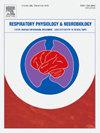模拟体内氧-血红蛋白解离曲线的分布:一项观察性研究
IF 1.6
4区 医学
Q3 PHYSIOLOGY
引用次数: 0
摘要
很少有研究探索体内氧-血红蛋白解离曲线的变异性。从2020年2月1日至2021年12月31日期间入住英国一家大型教学医院的7656名患者中获得了96,428项血气测量(80,376项动脉测量,6959项静脉测量),这些患者入院时与Covid-19相关,PCR阳性。氧-血红蛋白曲线分布在大多数氧饱和度地层中具有一致的变化,典型值为91-92 %饱和度(平均8.1kPa,标准差sd 0.6 kPa或60.8 mmHg sd 4.5 mmHg),但氧饱和度最高的地层为99-100 %(平均17.7 kPa,标准差8.1kPa或132 mmHg sd 60.8)。考虑到在高氧饱和度目标的随机对照试验中观察到的死亡率增加,高氧饱和度下的高氧分压是一个值得关注的问题。然而,观察性研究的设计排除了任何因果关系的归因。本文章由计算机程序翻译,如有差异,请以英文原文为准。
Modelling the distribution of the oxygen-haemoglobin dissociation curve in vivo: An observational study
Few studies have explored the variability of the oxygen-haemoglobin dissociation curve in vivo.
96,428 blood gas measurements were obtained (80,376 arterial, 6959 venous) from a cohort of 7656 patients who were admitted to a large UK teaching hospital between 1 February 2020 and 31 December 2021 for a Covid-19 related admission with a positive PCR. There was consistent variation of the distribution of the oxygen-haemoglobin curve across most oxygen saturation strata with typical values at 91–92 % saturation (mean 8.1kPa, standard deviation sd 0.6 kPa or 60.8 mmHg sd 4.5 mmHg), with the exception of the highest strata of oxygen saturation of 99–100 % (mean 17.7 kPa, sd 8.1kPa or 132 mmHg sd 60.8).
The higher oxygen partial pressures at higher oxygen saturations are a concern in view of the increased mortality observed in RCTs of higher oxygen saturation targets. However, the observational study design precludes any attribution of causality.
求助全文
通过发布文献求助,成功后即可免费获取论文全文。
去求助
来源期刊
CiteScore
4.80
自引率
8.70%
发文量
104
审稿时长
54 days
期刊介绍:
Respiratory Physiology & Neurobiology (RESPNB) publishes original articles and invited reviews concerning physiology and pathophysiology of respiration in its broadest sense.
Although a special focus is on topics in neurobiology, high quality papers in respiratory molecular and cellular biology are also welcome, as are high-quality papers in traditional areas, such as:
-Mechanics of breathing-
Gas exchange and acid-base balance-
Respiration at rest and exercise-
Respiration in unusual conditions, like high or low pressure or changes of temperature, low ambient oxygen-
Embryonic and adult respiration-
Comparative respiratory physiology.
Papers on clinical aspects, original methods, as well as theoretical papers are also considered as long as they foster the understanding of respiratory physiology and pathophysiology.

 求助内容:
求助内容: 应助结果提醒方式:
应助结果提醒方式:


